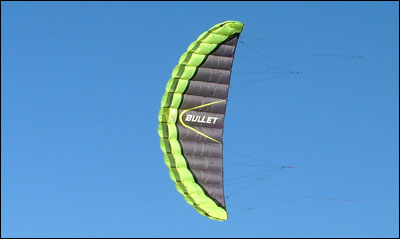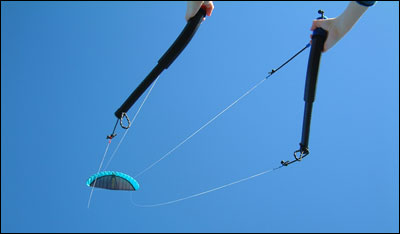I have had this kite on loan from Flexifoil for 10 days. Numerous people have flown it. Wind speeds have ranged from 8mph up to 20mph. It has been buggied with, boarded with and just flown around the beach with.
So it's a Flexifoil and in keeping with the general cynicism it would be "cool" to report that this kite is OK but nothing special; however, you cannot keep from grinning when flying this kite; it just loves to fly and people love to fly it. I even had the amusing spectacle of a PKA Instructor trying to axle it (!).
What is it?
Well general purpose traction kite obviously... and interestingly the Flexifoil Website list uses in the following order (possibly alphabetical): Buggying, landboarding, recreational; and that seems to sum it up.
It appears to be positioned as a good value starter kite that is stable enough for a beginner but with enough fun/fear factor to keep you amused as you get more skilful. The kite comes in only four sizes 1.5m through to 4.5m.

First Impressions
Ten out of ten for the package. Yet another sexy ballistic nylon rucksack to add to the collection: mesh front for those damp days and padded back support, lots of snap clips (most of which have unknown uses).
Choice of handles or a bar (although the bar is not quite ready yet Flexifoil tell me). Standard Flexifoil handles have been jazzed up with neoprene colour coded tops and leader covers (to stop chaffing on top fingers) - amazing how a bit of neoprene adds a touch of class to any sporting product!
Safety!!
Big shocker is the pre-attached kite killer. Velcro wrist straps are attached to both the brake lines via a bungy. You can remove these and I imagine that most flyers will do this; however, this is clearly a big step forward in terms of the responsibility that manufacturers are taking for the safety of their products. The only issue is going to be how having an extra bit of cord is going to get in the way when flying with a harness.
Other Bits
Usual package of instructions, sticker and guarantee!

Technical Bit
You can skip this bit if easily bored...
It's a ram air foil - ho hum - fully vented along the leading edge with 17 cells in the 3.5m kite increasing to 19 in the 4.5m version. Wing span is 3.6m. Sail material is Chikara and sleeved Dyneema lines for the bridles. Slightly unusual shape sort of like a wedge of lemon or as Flexifoil put it "Elliptical Area Distribution" this makes for a slightly unusual aspect ratio as it looks more like a (| than a () . Imagine a segment of a Cadbury's Chocolate Orange. Flexifoil anticipate that the most popular size will be the 3.5m kite.
Set up
So up to the kiting field. Wind blowing 8 mph. Well according to my wind meter (!) it is. Probably not enough for this kite.
Unwrap
Another bonus mark coming up. The bridle lines have all been locked into a card board card that details the colour coding for flying lines and brake lines and left and right. So no more guessing which line looks thicker and which side is which. On re-packing there are a couple of handy bits of Velcro (called "Croc Grips") in the middle of the trailing edge that allow you to lock each sides bridle lines in so keeping them separate and untangled when packing. Ozone kites have something similar on the leading edge and it works very well. The Flexifoil site says these will also help with self-launching (?) but did not try this.
Line is supplied on winder and the colour coding on the leaders matches up with the card!
As a result the first set up and unwind is relatively painless - no kite flapping around in the wind as you try and attach right lines.
Construction
Usual high quality Flexifoil construction. Leading edge is single seam with gauze covered vents all the way along the leading edge. The specification says that the cells have been reinforced to improve crash protection - difficult to check this. Overall construction seems fairly simple.
There is no trailing edge opening system for emptying sand but with full leading edge venting this should not be too much of an issue.
The Fluff
Lines attached and handles pegged out, fluff the kite and it sits nicely on the turf, but with the wing tip bridle lines incorrectly attached - not so good; but a minor niggle that takes a couple of minutes to sort out
Pick up wrist loops and attach and then pick up handles - put down tangled handles, reattach wrist loops, pick up again. Feels a bit odd but one of those things that will make beginners feel a bit more secure and gives another option if things get a bit hairy.

Flying
Launch
Centre of the window launch and kite goes up quicker than a rat up a drainpipe. This is a fast kite even in light winds. Kite pulls as it climbs but settles neatly over head with no hint of overflying. No discernible lift which kite boarders may find disappointing.
Brake Line landing
Brakes have to be applied firmly to get the kite to land; there is no immediate collapse and bag of dirty washing falling to the ground; however, you have to make sure you keep the brakes on as the kite will start flying again with very little provocation. Landing to the side of the windows is a definite for beginners. In high winds (beach in Norfolk) landing on brakes alone was very hard work. Adjusting the length of the brake lines just causes a nasty crease in the trailing edge so presumably this is how the kites are supposed to be tuned.
Reverse Launch
For the same reason that landing on the brakes is hard a reverse launch is a cinch. Kite flies very neatly backwards and flipping the kite and landing is straightforward, again you have to apply a firm hand to the brakes otherwise the kite will get away with you.
Emergency Landing
OK so I tested the emergency system and it works. Letting go of the handles the kite de powered almost immediately; I was concerned that the kite might flip and start flying backwards but it stayed stable and came down slowly.
Static Flying
This kite loves to fly. It is quick and exceptionally agile through the air. Hand/arm input for turns is minimal and you do not need to apply much brake to tighten the turn. Everyone who flew it commented on its speed through the air and how chuckable it was.
With quite a bit of work and effort it can be made to collapse but recovery was painless. This is not that surprising given the size and depth of the kite but it inspired confidence; hopefully this will also be evident in the larger size with the greater number of cells.
The positioning and sensitivity of the brakes means that the brakes can be used to stop the kite in mid air and allow you to reverse the kite in the window; overall controllability while flying is very good.
Torque
The power band is wide and consistent and in low winds was very controllable. The speed of the kite helps enormously in developing smooth power delivery and the ability to turn the kite quickly means there are no nasty surprises on up or down turns. In high winds stability is maintained although the kite is a good deal twitchier. Up wind performance seems good with kite flying out to the side and developing pull all the way; there is plenty of warning when the power is going to drop and no unexpected luffing.
I would imagine that the ideal wind speed for this kite is around 12-15mph (certainly for fat boys like myself!)
Gust Resistance
In a low gusty wind the kite is solid and there is no luffing or folding if there is a sudden loss of pressure. High wind performance was excellent and again no significant lift was generated over head.
Buggy/Board Flying
Conditions were not ideal for the kite pulling a 16 stone lump of fat down the field. But impressively the kite even manages to haul me around a bit. Even managed to get back up wind although had to work the kite quite hard.
Boarders in the same conditions reported that they would have liked more wind but that the kite was stable and easy to fly on a board. As mentioned above the lack of lift may be a limiting factor for some land and snow boarders
On the beach with the buggy in 16mph winds the whole thing became a lot more fun. Kites pulls strongly and evenly and down turns and up turns were controllable and produced controlled up turns and good power in down turns. No problems with lift and even when gusting up to 22mph.
You will probably not set any land speed records with this kite but it is very solid and dependable and produces good if not dramatic torque.
Up-wind performance is good, although you have to keep the kite moving to take advantage of it. Leaving the kite to fly results in the kite slowing down and losing power.
A couple of beginners tried this and were very comfortable with the kite saying that it was a lot less scary than some of the kites they had flown.
Packing
No problem and the addition of the Velcro bridle separators make things a good deal easier.
Pricing
Now this is where the fun starts:
Bullet 3.5 : £239
Little Devil 3.0m : £209
Little Devil 4.5m : £269
Blade 3.0m : £295
Blade 4.9m : £329
Cunning or what?!
Conclusions
There is no doubt Flexifoil will sell large numbers of these. As an advanced static traction kite for recreational use this will be very hard to beat; added to that is the fact that this will provide a good engine for either buggying, land boarding or snow boarding and most entrants to the sport will find this an irresistible combination.
Intermediate to expert buggy users will probably decide that this is not fast enough for them and experienced land boarders will probably be waiting for the Blade 3 to see if this is going to deliver the ultimate solution for them. This is a good starter kite and coupled with one of the new Flexifoil landboards will be an irresistible combination for most people wanting to get into the sport. This alone guarantees success.
A number of experienced buggiers said the price and stability would also attract them and felt this might be a great high wind kite.
By : William James



Recommended Comments
There are no comments to display.
Join the conversation
You can post now and register later. If you have an account, sign in now to post with your account.